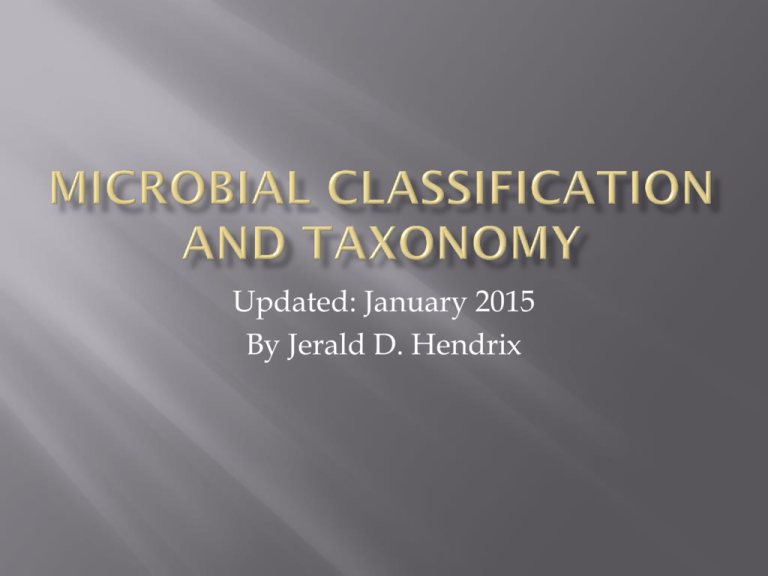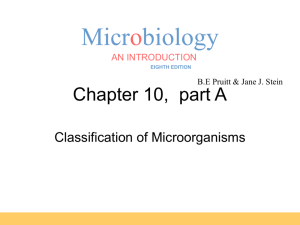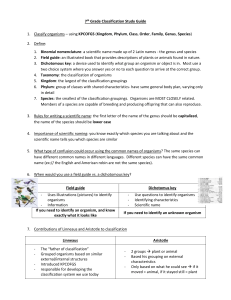Microbial Classification and Taxonomy
advertisement

Updated: January 2015 By Jerald D. Hendrix A. B. C. D. E. Classification Systems Levels of Classification Definition of “Species” Nomenclature Useful Properties in Microbial Classification Taxonomy: Phenetic Classification System: Classification of living organisms into groups Groups do not necessarily reflect genetic similarity or evolutionary relatedness. Instead, groups are based on convenient, observable characteristics. Phylogenetic Classification System: Groups reflect genetic similarity and evolutionary relatedness Cladistic taxonomy: Organisms are placed in groups (clades) based on comparison of their genomic structure (nucleic acid sequence), with notable attention given to the 16S rRNA sequence Taxon: A group or “level” of classification Hierarchical; broad divisions are divided up into smaller divisions: Kingdom (Not used by most bacteriologists) Phylum (Called “Division” by botanists) Class Order Family Genus (plural: Genera) Species (Both singular & plural) Many traditional taxa have been “replaced” or superceded with clade designations Monophyletic taxon: A group that belongs to a single clade Polyphyletic taxon: A group that contains organisms from several clades, or that is in the same clade as organisms in a different taxon Example: Birds, reptiles, dinosaurs (rawrrh) The “basic unit” of taxonomy, representing a specific, recognized type of organism For sexually reproducing organisms, a fundamental definition of “species” has been reproductive compatibility This definition fails for many microbial species (including bacteria), because they do not reproduce sexually Definition of “species” in microbiology: Classic definition: A collection of microbial strains that share many properties and differ significantly from other groups of strains Species are identified by comparison with known “type strains”: well-characterized pure cultures; references for the identification of unknowns There are several collections of type strains, including the American Type Culture Collection (ATCC) Definition of “species” in microbiology (cont.): Strain: A population of microbes descended from a single individual or pure culture Different strains represent genetic variability within a species Biovars: Strains that differ in biochemical or physiological differences Morphovars: Strains that vary in morphology Serovars: Stains that vary in their antigenic properties Scientific name (Systematic Name) Binomial System of Nomenclature Genus name + species name Italicized or underlined Genus name is capitalized and may be abbreviated Species name is never abbreviated A genus name may be used alone to indicate a genus group; a species name is never used alone eg: Bacillus subtilis B. subtilis Common or descriptive names (trivial names) Names for organisms that may be in common usage, but are not taxonomic names eg: tubercle bacillus (Mycobacterium tuberculosis) meningococcus (Neiserria meningitidis) Group A streptococcus (Streptococcus pyogenes) Colony morphology Cell shape & arrangement Cell wall structure (Gram staining) Special cellular structures Biochemical characteristics Serological Tests Use group specific antiserum isolated from the plasma of animals that have been sensitized to the organism The antiserum contains antibody proteins that react with antigens on the unknown organism. The reaction can be detected by examining agglutination or by using sera labeled with colorimetric or fluorescent labels Serological Tests (cont.) Advantages: Highly specific Does not usually require the organism to be isolated into pure culture Can be used to identify organisms that can’t be grown on medium G + C content GC Mol% (G C) 100% GCAT Estimated by determining the melting temperature of the DNA Higher G + C gives a higher melting temperature Nucleic acid hybridization By mixing ssDNA from two different species and determining the percentage of the DNA that can form dsDNA hybrids The greater the percent hybridization, the closer the species Nucleic acid sequencing Genes for specific enzymes The nucleic acid sequence for the complete genome of several species is now available 5S and 16S rRNA (ribosomal RNA) sequences; comparison of these sequences has been extensively used to determine the phylogenetic relationships of microbial groups Bergey’s Manual of Systematic Bacteriology In 1927, David Bergey & colleagues published Bergey’s Manual of Determinative Bacteriology, a manual that grouped bacteria into phenetic groups, used in identification of unknowns. It is now in its 9th edition. In 1984, a more detailed work entitled Bergey’s Manual of Systematic Bacteriology was published, still primarily phenetic in its classification. Bergey’s Manual of Systematic Bacteriology Publication of the second edition of Bergey’s Manual of Systematic Bacteriology was begun in 2001. The 2nd edition gives the most up-to-date phylogenic classification of prokaryotic organisms, including both eubacteria and archaea. When it is completed, it will consist of 5 volumes. The classification in Bergey’s Manual is accepted by most microbiologists as the best consensus for prokaryotic taxonomy. Domains Based on the research of Woese and others in the 1980s and 1990s, most biologists divide all living organisms into 3 domains: Domain Archaea Domain Bacteria Domain Eucarya rRNA sequence data suggests that Archaea & Eucarya may share a more recent common ancestor with each other than with Bacteria Diagram Domains (cont.) Many microbiologists reject the “kingdom” designation. Each domain is divided into phyla, phyla into classes. etc. There is often great metabolic and ecological diversity among the members of a group, perhaps reflecting parallel evolution of such things as fermentation pathways, photosynthetic pathways, etc.




